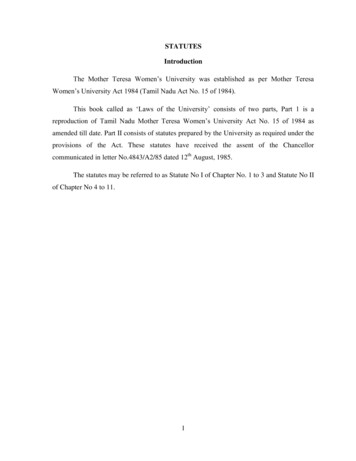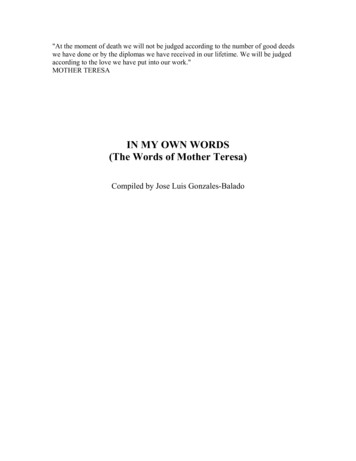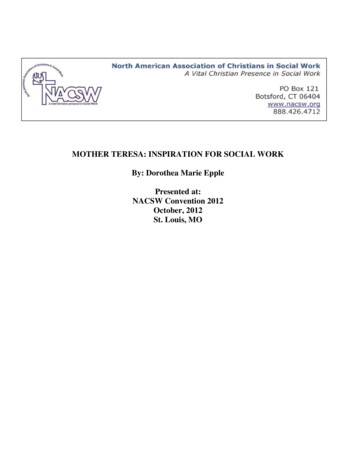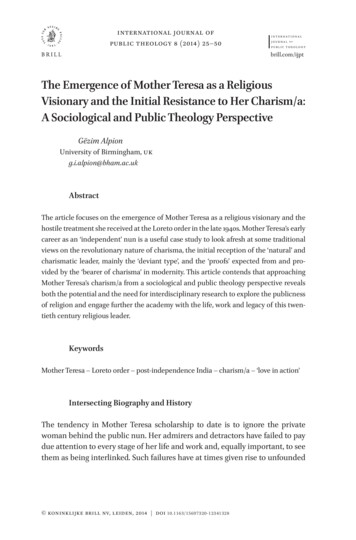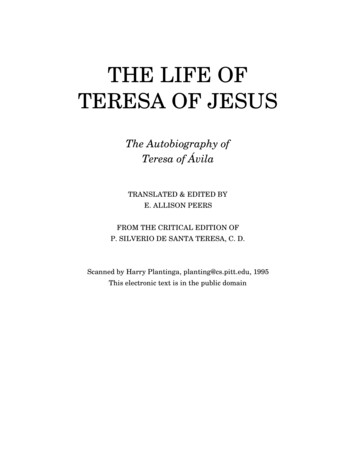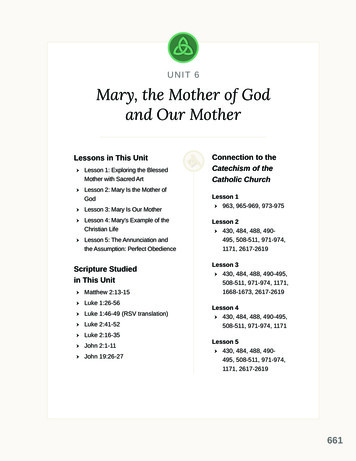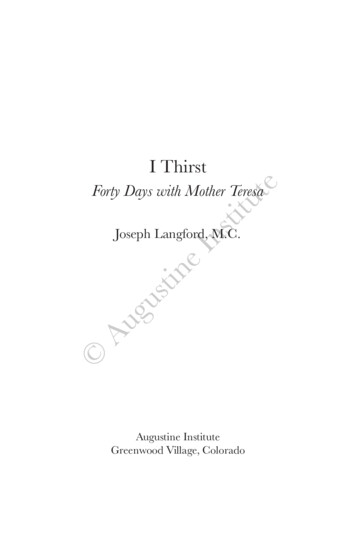
Transcription
I ThirstInstituteForty Days with Mother Teresa AugustineJoseph Langford, M.C.Augustine InstituteGreenwood Village, Colorado
Augustine Institute6160 S. Syracuse WayGreenwood Village, CO 80111Tel: (866) Unless otherwise noted, Scripture quotations are fromRevised Standard Version of the Bible—Second Catholic Edition (Ignatius Edition)Copyright 2006 National Council of the Churchesof Christ in the United States of America.Used by permission. All rights reserved worldwide.Cover Design: Lisa Marie Patterson Au 2018 by the Missionaries of Charity, Kolkata, IndiaAll rights reserved.ISBN: 978-1-7325247-5-0Library of Congress Control Number 2018954334Printed in the United States
gustineInstituteMother Teresa, Saint Teresa of Calcutta (1910–1997), thefounder of the Missionaries of Charity, was a figure knownand loved around the world for her work among the poor.Born in Albania, she entered the convent of Loreto at ageeighteen and went as a missionary to India a year later. In1946, on a train ride to Darjeeling, she had a profoundencounter with Christ that led her to a new vocation ofserving the very poor. She started going into the streets ofCalcutta to bring comfort and help to those most in need.In 1950 she received permission to found her new Society.The Constitutions of the Missionaries of Charity spoke ofits aim as satiating the thirst of Jesus by serving the poorestof the poor, and in all the chapels of her sisters, MotherTeresa had Jesus’ words from the Cross—I thirst—inscribednext to the crucifix. AuFr. Joseph Langford (1951–2010) co-founded with MotherTeresa the Missionary of Charity Fathers in 1984 and wasthe author of Mother Teresa’s Secret Fire (OSV, 2008). Herecognized in Mother Teresa’s encounter with the thirst ofJesus and her emphasis on satiating that thirst a powerfulsymbol of God’s love for each person and a road intoexperiencing that love more profoundly. The meditationsgathered here are from the text of his unpublished notes forthe retreat on Mother Teresa’s spirituality that he regularlygave both to the Missionaries of Charity congregations andto many other groups.
gustineAuInstitute
ContentsixPrologueDay 1. The Woman at the Well, Part IDay 2. The Woman at the Well, Part II37InstituteIntroduction: Mother Teresa and the Thirst of God131620242730II. Prayer as ThirstDay 9. Come and SeeDay 10. Elements of PrayerDay 11. Entering Deep PrayerDay 12. The Importance of TrustDay 13. Growing in Our TrustDay 14. The Eucharist374044485154 AugustineI. The Dynamics of ThirstDay 3. Rivers of Living WaterDay 4. Sin as False ThirstDay 5. Patterns of Thirsty AttachmentsDay 6. Jesus the HealerDay 7. The Need for FaithDay 8. Reviving Our Spiritual Life
596265687275uteIII. Our Lady’s ExampleDay 15. Our Lady at CanaDay 16. Our Lady at CalvaryDay 17. Our Lady in the ChurchDay 18. Two Lives, One VocationDay 19. The Little Way and the Thirst of GodDay 20. The Immaculate Heart of MarygustineInstitIV. Thirst in the Service of GodDay 21. The Secrets of the Kingdom81Day 22. The Burning Bush85Day 23. God’s Thirst Everywhere Present89Day 24. Charity92Day 25. Compassion: The Continuing Thirst of Christ 95Day 26. Staying the Course of Compassion99 AuV. Sharing in the Thirst of ChristDay 27. Peter and the CrossDay 28. Our Wounds as ThirstDay 29. Poverty and the Thirst of ChristDay 30. Suffering with ChristDay 31. Surrendering to the Wounds of the CrossDay 32. The Offering to Divine Thirst105108112116119122
InstitVII. Satiated ThirstDay 39. Easter SerenityDay 40. The Gift of the SpirituteVI. Jesus, the Incarnation of God’s ThirstDay 33. The Mystery of the CrossDay 34. The Agony of GethsemaneDay 35. Peter and JudasDay 36. Jesus and PilateDay 37. I ThirstDay 38. Holy Saturday AugustineEpilogue: Keeping Our Eyes on the Reward129133137141144147153156160
gustineAuInstitute
Introduction – Mother Teresaand the Thirst of GodgustineInstituteIn his thirst, the dying Christ seeks a drink quite differentfrom water or vinegar. Now, on the Cross, Jesus thirsts fora new humanity which should arise from his sacrifice infulfillment of the Scriptures. The thirst of the Cross, on thelips of the dying Christ, is the ultimate expression of thedesire of a baptism to be received and of a fire to be kindledon the earth, which had been manifested by him during hislife. Now the desire is about to be fulfilled, and with thosewords Jesus confirms the ardent love with which he desiredto receive that supreme “baptism,” to open to all of us thefountain of water, which really quenches the thirst and saves.Au—Pope St. John Paul II (General Audience, 1988) Jesus is God, therefore his love, his thirst, is infinite.The aim of our [Missionary of Charity] Society isto quench the infinite thirst of a God made Man.The first words of our Constitutions, the aim,“I thirst”—are we too busy to think about that?The words, “I thirst”—do they echo in our souls?I do not know whose thirst is greater, his or mine for him.—Mother Teresa (1950; Instructions, 1980; Letter, 1980)Mother Teresa andthe Thirst of Godix
xI Thirst AugustineInstituteEveryone associates Mother Teresa with work amongthe “poorest of the poor,” a mission that she inauguratedamong many peoples on every continent. But few have anyidea of her real message, of the hidden fire that burnedwithin her and urged her on to do all that she did with suchcompassion and love.The message behind all of Mother Teresa’s missionaryactivity is simple but staggering: in the poverty and Cross ofJesus, God has revealed his thirst for us and for our love. Yetthis is more than just a verbal message; it is first of all a realityto be encountered and experienced, over and over again,ever more deeply.When Jesus was suffering on the Cross, one of the criesthat came from his lips was “I thirst!”* What does this cryof “I thirst!” express? First and most importantly, it expressesGod’s thirst for us. Jesus, speaking in his divine nature,revealed something about God that we would otherwise nothave known: that God thirsts for us and for our love. Butspeaking in his human nature, Jesus also revealed somethingabout ourselves that we may never have known: that manis a living thirst for God. The cry “I thirst!” refers to bothGod and man. Ever since the Fall of our first parents, bothGod’s thirst for humanity and humanity’s broken thirst for*Jn 19:28.
Mother Teresa and the Thirst of Godxi AugustineInstituteGod has gone unquenched. God had intended there to be acontinually quenched communion of thirsts between himselfand his human children, but instead there was only distanceand separation. On the tree of Calvary, for the first time sincethe eating from the fateful tree of Eden, the thirst of Godand the thirst of man were brought together in completeharmony in the Person of Jesus.The divine cry “I thirst!” echoes throughout the wholeof salvation history. The Old Testament is a careful andmagnificent preparation for the full revelation of the Lord’sthirst on the Cross. Jesus had come to fulfill the revelation ofGod’s thirsting love already begun as a distant echo in Adamand Abraham. Jesus brings all these threads of revelationtogether in himself. Those Old Testament figures preparedhis coming, and, in his light, we can see the fullness of theirmeaning and beauty.Creation itself is a spilling over of God’s infinite thirstto love and to be loved, even beyond the borders of theTrinity. It is the fruit of a divine expansiveness to share thislove. The creation of the angels, the bringing forth of thematerial universe, the creation of man and woman, ourown unique creation—all are expressions of God’s infinitethirst to love and to be loved.Think of the thirst that seems inborn in the createduniverse. Creation ceaselessly thirsts for God the Creator,
xiiI Thirst AugustineInstitutewithout whom it cannot exist. Even inanimate creation isa symbol of this universal thirst for God. Yet man is thegreatest reflection of God’s thirst, since he alone is createdin God’s image. If God is a thirst, then so too are we: aliving thirst to love and to be loved.Then think of the Fall. God is life, and when ourfirst parents turned their thirst away from him and towardthe self, they brought death upon themselves. Both God’sthirst for man and man’s frustrated thirst for God wereimmeasurably increased after the Fall.God then chose Israel as a symbol and channel of histhirst for, humanity. He traced out their path to restorationby giving them the great commandment to thirst for him.Love desires, thirsts for intimacy: for the opportunity to knowand be known by the beloved, and to share life together.The covenant bond established between God andIsrael was spoken of by God as his marriage with hisPeople. He chose the most complete symbol of mutuallythirsting love. The Song of Songs symbolically prefiguresthe wedding of God and humanity; the final chapters of theBook of Revelation portray its fulfillment with the marriageof the Lamb.When God’s thirst is united with human thirst, as itwas on Calvary, miracles of grace and resurrection occur.Here we find the secret to the Christian vocation: the union
Mother Teresa and the Thirst of Godxiii AugustineInstituteof these two thirsts in our own heart. Too often, what ismissing in this desired union of thirsts is our own thirst forJesus. If we look closely at Mother Teresa we will find thather single most striking characteristic—beyond her charity,beyond her zeal—was her profound thirst for Jesus. Thisthen is the doorway through which to walk if we wish todeepen our own experience of the thirst of Jesus for us,the same door that opened God’s thirst for Mother Teresa:the renewal and the deepening of our own thirst for him.Our thirst for God is the unseen element that completesthe mystery of Jesus’ cry of thirst as both God and man onCalvary. Our thirst for God is the same element that allowsus to recreate the fullness of that mystery in our own lives.If we wish to experience resurrection power and life, bothof these elements need to be present as they were at theCrucifixion: Jesus’ thirst for us and our thirst for him.Jesus desires, thirsts for, our own thirst for him, notas mere bit of sentimentality, but as an all-consumingimpetus of the soul, through which we open ourselvesentirely to him in trust and surrender ourselves completelyto him in love.No matter how far I may have traveled in myknowledge and experience of Jesus’ thirst, the only path todeepen that encounter is for my own thirst for him to berenewed. What is equally important, my thirst for him is the
xivI Thirst AugustineInstituteonly way to satiate his thirst. Again, we come up against thisamazing truth: Jesus thirsts for my thirst.This is that dual thirst, of God for humanity andof each of us for God, that Mother Teresa experiencedinternally, and that she sought to communicate to all whomshe met and touched. The purpose of these pages, despitetheir human poverty, is to encourage and assist you in yourown encounter with Jesus’ thirst—an encounter that canchange your life and the lives of those through whom youtouch him every day.
gustineAuInstitutePrologue
gustineAuInstitute
Day 1 The Womanat the Well, Part IDay 1 The Woman at the Well, Part IInstituteThere came a woman of Samaria to draw water.Jesus said to her, “Give me a drink. . . . If youknew the gift of God, and who it is that is saying toyou, ‘Give me a drink,’ you would have asked himand he would have given you living water.”gustine—John 4:7, 10Our aim is to satiate the infinite thirst of God,not just for a glass of water, but for souls.Souls are immortal, precious to God. Au—Mother Teresa (Instructions, 1983)The dynamics of divine and human thirst can be seen withgreat clarity in John’s Gospel, in the account of Jesus and theSamaritan woman (see Jn 4:1–30). In this encounter, Jesuscarries on a lengthy conversation with a woman of Samariawho has come to draw water from the town’s well. Throughthis conversation, Jesus leads the woman from a firstexperience of his thirst, on toward full conversion and zeal.3
4I Thirst AugustineInstituteMother Teresa was fond of saying that we are made“to love and to be loved.” Everyone thirsts for love. In thisgospel encounter there is symbolic importance in many ofthe details of the meeting. The well of water symbolizes thesearch for love, the place where people come in their thirst tofind relief. Samaria, whose inhabitants were thought by theJews to be far from God, symbolizes a life of sinful wandering.Jesus has arrived at the well and is sitting by it, tired out. Wecan see that even before we begin our search for God, even inthe midst of our sins, Jesus is already there waiting for us. Hehas tired himself out in his long search for our love.The Samaritan woman symbolizes our human poverty.As a Samaritan she had no religious dignity in Jewish eyes,and as a woman of the time she occupied a subordinate socialposition with little power. We can see her as representing theemptiness, the alienation from God, and the loss of humandignity that has come about through self-centered thirsts. Yetshe desires love, and, in her search, she has come to drawwater “at the sixth hour” (noon) when the heat, and thereforeher thirst, is greatest. At the very moment of her greatestneed, at the very place of her mistaken human search, Jesusspeaks to her: “Give me a drink . . . ”The woman is at first reluctant. She replies, “How is itthat you, a Jew, ask a drink of me, a woman of Samaria?”(v. 9). She is voicing our own hidden doubts and hesitations
Day 1 The Woman at the Well, Part I5 AugustineInstitutebefore the invitation of the thirst of Jesus: “Can he really meanme? Does he really thirst for me? Maybe a saint like MotherTeresa, yes, but me? How could I ever satiate his thirst?”Jesus shows us that “giving him something to drink” isnot ultimately our gift to him, but rather his gift to us. Onlyin the encounter with his thirst can our own desire to love andbe loved be satiated. Jesus’ thirst for us awakens our thirst forhim. If we ask, if we thirst for him, he will us give anotherand better “water” than any we have found before: the livingwater of his infinite love.“Jesus said to her, ‘Every one who drinks of this waterwill thirst again, but whoever drinks of the water that I shallgive him will never thirst; the water that I shall give himwill become in him a spring of water welling up to eternallife’ ” (vv. 13–14). Again, the meaning is symbolic. The onewho seeks only human love to quench his or her thirst willbe thirsty always, for mere human love, especially when it issought selfishly or sinfully, can never satisfy the depths of thehuman heart. But those who seek love in God will never lack,will never be empty, and will never thirst in vain. The morethey thirst, the more Jesus will fill them with his own thirst forthem, which is his love. He does not need exterior means tocommunicate that love; it will become a living source withinthem, always growing, until finally it will overflow into thefulfillment of eternal life.
6I Thirst AugustineInstitute“The woman said to him, ‘Sir, give me this water, that Imay not thirst, nor come here to draw’ ” (v. 15). The tactic hasworked. For the first time the woman expresses her thirst forwhat Jesus has promised to give. This is the turning point inher conversion. She had already met Jesus’ thirst for her, butnothing had changed until she allowed his thirst to awakenher own. The thirst of God touched the thirst of the woman,and the miracle of grace began.The Samaritan woman has taken a crucial step forward.Not only is she moving toward thirsting for Jesus, but she isbeginning to make that thirst her one desire. She wants alove that will not need constant replenishment from without.This is important for her transformation. Conversion meansthe gradual passing from a thirst for Jesus and others (persons,possessions, events, and circumstances) to having only onethirst—Jesus. The woman has begun to realize a great truth:that all other thirsts will not only fail to satisfy her, but thosethirsts tire out her soul. To thirst only humanly drains andfatigues, even in the midst of ease and success. To thirst forGod energizes and enlivens, even when accompanied by toiland trial.
Day 2 The Womanat the Well, Part IIDay 2 The Woman at the Well, Part II—John 4:28uteSo the woman left her water jar . . .gustineInstitWe have been created to love and be loved, and God hasbecome man to make it possible for us to love as he lovedus. He makes himself the hungry one, the naked one, thehomeless one, the sick one, the one in prison, the lonely one,the unwanted one. . . . He is hungry for our love.Au—Mother Teresa (Nobel Peace Prize Acceptance Speech, 1979) Let us continue our meditation on the meeting of Jesusand the Samaritan woman. After she has requested fromJesus the water that will last, he gives her a seeminglyrandom direction. “Jesus said to her, ‘Go, call yourhusband, and come here’ ” (Jn 4:16). In saying this Jesusis not looking for an opportunity to condemn the woman.He is inviting her to take a final step toward satiatingboth him and herself by examining her false thirsts. Atfirst, she only acknowledges her general state of infidelity7
8I Thirst AugustineInstituteand illegitimate thirst: “I have no husband” (v.17).But Jesus responds by telling her that she has had fivehusbands. He wants her to discover in detail the existenceof all her false thirsts, one by one, for unless they areacknowledged and seen as false, they will continue tooppress her.Jesus then said to her: “And he whom you now have isnot your husband” (v. 18). Here Jesus is showing her that herfalse thirsts are not just mistakes, they are infidelities in loveto the one who alone is the spouse of the soul. By clinging toour various human thirsts—our desires, our limited hopes,our possessions, our plans and ambitions—in a sense we“espouse” them. And in each case Jesus reminds us that this“is not your husband.” The thirst you have joined yourself tois not your true spouse. If we persist in such thirsts withoutany effort to examine them, we wound not only ourselves butthe Lord.“The woman said to him, ‘I know the Messiah iscoming . . . when he comes, he will show us all things.’ Jesussaid to her, ‘I who speak to you am he’ ” (vv. 25–26). It is asif the woman had said: “I have heard about and have feltwithin me the truth of what you say; and maybe someday,when things are better, when life is less complicated, when‘the Messiah comes,’ then I’ll be able to do something aboutall this. Later.” But Jesus is speaking to her now. The time has
Day 2 The Woman at the Well, Part II9 AugustineInstitutecome. The Messiah is here. There is no need to wait for adifferent situation or a better set of conditions. Jesus is presenteven now to teach us how to satiate his thirst to the full.Finally, grace triumphs in the woman’s heart. She putsdown her water jar: she no longer needs her old false thirsts,her previous means of seeking love. She has come to trustJesus, and, in an act of surrendering her old life with its manythirsts, she goes joyfully to share the invitation of Jesus’ thirstwith others, an invitation not just to believe, but to experiencethat thirst for themselves.The encounter of Jesus with the woman at the wellshows us that when Jesus reveals his thirst for us (“Give me todrink”), he is trying to awaken our thirst for him (“Give methis water that I may not thirst”). Once we begin to expressour thirst for him, to bring these two thirsts together, ourconversion and our satiation begin.What then is this thirst for Jesus, for God? How is itexpressed? It is not simply a feeling, though it may touchour feelings. It is a desire of our will, and therefore it isalways possible to us, whether we happen to be experiencingconsolation or aridity. Our innate poverty, our weakness, allour needs are already a great thirst. Our interior being is aliving thirst that needs only to be directed to God. If this werenot so, what hope would any of us have of answering Jesus’invitation? But we have a potent thirst already at work within
10I Thirst AugustineInstituteus. It needs only to be purified, unified, and focused on Godin Christ.Once we have begun to thirst for God, we becomeaware of many other thirsts that war against that thirst, secretmotives and desires that we may not admit to ourselves noreven be fully aware of. Like the Samaritan woman, we needthe courage to allow the Lord to point out to us our “fivehusbands”; we need to let him reveal our many false thirsts sothat we might leave our water jars behind us and pursue theone thirst that can satisfy us.Jesus is thirsting for our thirst. Let us then, like theSamaritan woman, lay aside all those old water jars, and likeMother Teresa, let us fill the well of our hearts with that “onething necessary”—our profound thirst for Jesus alone.
AugustineInstituteI. The Dynamics of Thirst
gustineAuInstitute
Day 3 Rivers of Living WaterDay 3 Rivers of Living WaterInstit—John 7:37–38uteOn the last day of the feast, the great day,Jesus stood up and proclaimed, “If any one thirst,let him come to me and drink. He who believes in me,as the Scripture has said, ‘Out of his heart shall flowrivers of living water.’ ”gustineMy children, once you have experienced the thirst,the love of Jesus for you, you will never need, you will neverthirst for these things which can only lead you away fromJesus, the true and living Fountain.Au—Mother Teresa (Letter, 1993) All of God’s plan is contained in the verses above fromJohn’s Gospel.To appreciate their context, let us relive the scene. Jesushad gone privately to Jerusalem for the Feast of Tabernacles,one of the three great pilgrim feasts of the Jewish year.On this joyful feast the Jewish people would celebrate thebringing in of the harvest in a festival that recalled God’sdesire—his thirst—to dwell among his People in a simple13
14I Thirst AugustineInstitutetent (“tabernacle” from the Greek) during the forty yearsin the desert. To commemorate God’s care during thosedesert years, the Jews would erect small tabernacles andsymbolically live in them during the feast. God’s lovingpresence at that formative time of their history was likelife-giving and refreshing water in the dry emptiness of thedesert. He was their living water.The Feast of Tabernacles began with seven days ofcelebration. On the eighth day, the “great day” as it wascalled, a magnificent procession was held, led by the highpriest. As the procession began, the high priest would takea golden cup and go to the pool of Siloam, a refreshingreservoir of water that represented God’s healing andrestoring action among his people. The High Priest would fillthe cup with water from the pool and hold it up for all to see;he would then lead the people through the city, singing theverse from the prophet Isaiah, “With joy you will draw waterfrom the wells of salvation” (Is 12:3).The procession would eventually march out beyondthe city walls, where the high priest would symbolicallypour the water from the pool onto the dry desert ground.This gesture represented not only the renewal of Israel, butthe eventual satiating of all the nations’ thirst for God bya universal outpouring of the living waters—the Spirit ofLove—as foretold by the prophet Ezekiel. Every human
Day 3 Rivers of Living Water15 AugustineInstituteheart was one day to become a “tabernacle” for God’sliving waters.On this occasion, Jesus was present for the celebration.We can only imagine what was transpiring in his soul as hewatched and perhaps participated in the procession. Heknew that he was the feast’s fulfillment, that he was the onesent by the Father to satiate man’s thirst for God and God’sthirst for man. He was so deeply moved at the sight that hestood up and cried out in a loud voice: “Come to me all youwho thirst!” (Jn 7:37).This one phrase contains in summary all that God haswanted to say to man from the beginning of time. It expressesGod’s thirst for man: “Come to me!” It invites man to focushis thirst on God: “All you who thirst.” And it promises tofully satiate him with “rivers of living waters” (Jn 7:38). Jesushimself is the golden cup; it is he who pours out the livingwaters of the Spirit upon the thirsty ground of our souls.Through the symbolism of the Feast of Tabernacles,Jesus is inviting us to rediscover, in salvation history and inhis personal dealings with us, all the various manifestations,foreshadowings, and revelations leading up to the fullrevelation of his thirst in us and for us. We too can celebratethis feast in spirit. We too have been called into the desert,and Jesus has long been with us, and is even now awakeningin us the thirst for living waters.
Fr. Joseph Langford (1951-2010) co-founded with Mother Teresa the Missionary of Charity Fathers in 1984 and was . the author of . Mother Teresa's Secret Fire (OSV, 2008). He recognized in Mother Teresa's encounter with the thirst of Jesus and her emphasis on satiating that thirst a powerful symbol of God's love for each person and a .
